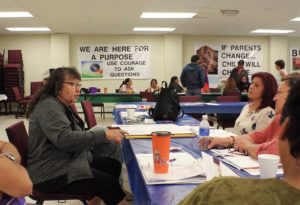‘Our main goal is prevention’ says Chief Waboose at Child Well-Being Working Group meeting

By Rick Garrick
LONG LAKE #58—Transitional housing and prevention services for children were raised as priorities during the July 12-13 Child Well-Being Working Group meeting in Long Lake #58.
“We shared with each other what we wanted to see, and our main goal was prevention,” says Long Lake #58 Chief Veronica Waboose on the second day of the meeting. “We have to have more money to prevent all of these things that are happening in our First Nation.”
Judy Desmoulin, health social director for Long Lake #58 and a member of the Child Well-Being Working Group, says that the transition housing will help children in care who are transitioning out of care.
“And the prevention part is key to keeping our families together [and] keeping our kids out of care,” Desmoulin says.
Tracey O’Donnell, legal counsel for the Child Well-Being Working Group, says that the meeting included discussions on proposals to be put forward to the provincial and federal governments to address immediate needs.
“One of the immediate needs that came out of this meeting was the establishment of transition housing for our youth who are in those teenage years and have been involved with the child welfare system [and] who are moving out on their own to provide them with that cultural support, the life skills support and the learning that they need as young adults to have a good life,” O’Donnell says. “We also had direction that we need to establish safe homes in each of our First Nations and have a place where families who are in crisis can go to have a safe environment to start working out their issues.”
About 10 members of the Child Well-Being Working Group attended the meeting from across Anishinabek Nation territory, including representatives from Manitoulin Island, Curve Lake and the Southwest region.
“The purpose of this meeting was to share information on what we are doing in child well-being and advancing the implementation of the Anishinabek Nation Child Well-Being Law,” O’Donnell says. “But more importantly, the purpose of this meeting was to get input from the working group members and the community members on what we need to do next and how we move forward and address the needs of our children and youth.”
The working group members acknowledged the large turnout from Long Lake #58 community members and staff for the meeting.
“It’s not the biggest community, but it’s had the most response from community members,” says Nipissing Councillor Cathy Bellefeuille, a member of the Child Well-Being Working Group. “We’ve been to lots of large communities, and we don’t get the community participation like this.”
The meeting included a summary and update on activities since the Child Well-Being Working Group’s last meeting in the spring as well as meetings with Indigenous and Northern Affairs Canada and the Ontario Children’s Lawyer.
“We have been very busy in meeting with the First Nations to review the Anishinabek Nation Child Well-Being Law and answering questions from the communities and their members on that law so that we can move forward to implement that law by April 1, 2018,” O’Donnell says. “We also talked about new opportunities that the First Nations may have in working in partnership with the Office of the Ontario Children’s Lawyer to support Anishinabek children and youth in child welfare matters.
The Anishinabek Nation Child Well-Being Law is posted online.


